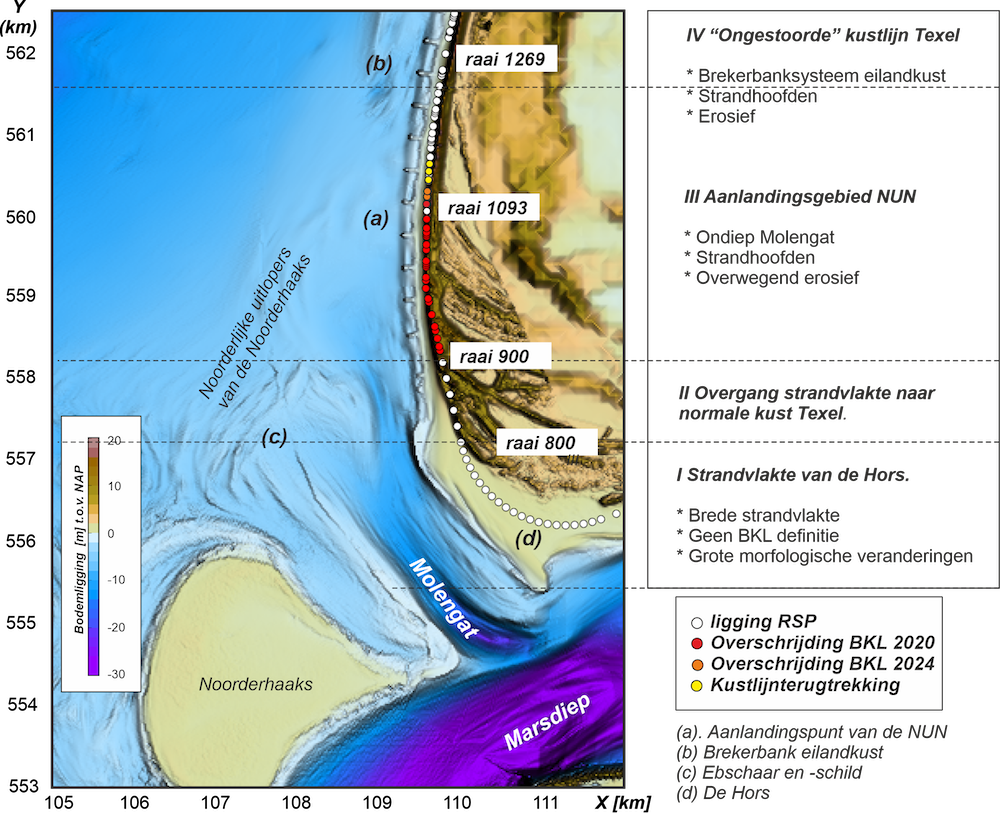S.R.P.M. Pluis1*, E.P.L. Elias2, Q.J. Lodder1,3
1 Rijkswaterstaat Water, Verkeer en Leefomgeving
2 Deltares
3 Delft University of Technology
*corresponding author:
Introduction
In 1990 a new policy framework of 'dynamic coastal preservation' was adopted in The Netherlands (Ministerie van Verkeer en Waterstaat, 1990). This policy framework encompasses the introduction of coastal sand nourishments to prevent structural coastal erosion and to keep the coastline (dynamically) in place. Rijkswaterstaat is the responsible authority for the planning and execution of these sand nourishments ever since the start of 'dynamic coastal preservation' in 1990.
One of the most intensively nourished sites along the Dutch coast is Texel Southwest, located between JarKus transect ('raai') 900 - 1269 (Figure 1). This area is characterized by structural erosion due to the presence of Texel Inlet (Elias & Van der Spek, 2017). Therefore, since 1990 more than 7,500,000 m3 of sand has been nourished to maintain the coastline. Recently, Rijkswaterstaat and Deltares collaborated in exploring system-based nourishment strategies for Texel Southwest that make use of coastal processes in order to reduce coastal erosion. These system-based nourishments can serve as an addition or alternative to the common practice of beach nourishments at Texel Southwest.

Figure 1. Morphological processes along the coast of Texel Southwest (Source: Elias et al., 2020).
Results
Four alternative nourishment strategies were identified and modelled, including: 1) extending the breaker bar system from JarKus transect 1269 in southward direction), 2) nourishing the Noordelijke Uitlopers of the Noorderhaaks ('NUN' in short), 3) XL beach nourishment between JarKus transect 900 - 1269, and 4) blocking the Molengat tidal channel along the tip of Texel Southwest. Research by Elias et al. (2021) suggests options 2 and 4 have potential to optimize the nourishment scheme at Texel Southwest by respectively reducing wave-driven erosion (breaker bar effect') and reducing tidal action.
References
Ministerie van Verkeer en Waterstaat, 1990. Kustverdediging na 1990; beleidskeuze voor de kustlijnzorg (in Dutch). Ministerie van Verkeer en Waterstaat, 's-Gravenhage, 65p.
Elias, E.P.L., Van der Spek, A.J.F. 2017. Dynamic preservation of Texel Inlet, the Netherlands: understanding the interaction of an ebb-tidal delta with its adjacent coast. Netherlands Journal of Geosciences – Geologie en Mijnbouw 96 (4), p. 293-317.
Elias, E., Roelvink, F., Pearson, S. (2021). Systeemsuppleties op Eilandkoppen – Synthese (in Dutch). Rapport 11205236-005-ZKS-0003, Deltares, Delft, 43p.
I. Surname1*, F.N. Another-Surname2 , Y. Next-Surname2
1 University Name, Country; 2 Organization Name, Country
* Corresponding author: mail.name@organization.org


